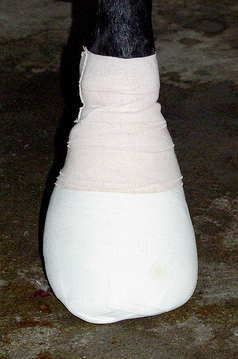CHAPTER 157 Management of Wounds in High-Motion Areas
Wounds over areas of high motion, such as the hoof, pastern, fetlock, carpus, tarsus, and structures of the head, necessitate special care to avoid the propensity of these areas to develop excessive granulation tissue, chronic bandage complications, and poor, prolonged healing. Movement from either the motion of a joint or the underlying tissues, such as an underlying tendon, can delay healing. Whereas some motion is required to ensure proper collagen alignment along lines of tension in wounds, excessive motion in a wound bed can disrupt angiogenesis and increase collagen deposition, which promotes chronic inflammation that will often lead to exuberant granulation tissue and poor-quality repair tissue.
HEEL BULB AND PASTERN AND FETLOCK LACERATIONS
To apply a slipper cast, cast stockinet is applied to the foot extending proximally to above the fetlock joint. The stockinet is followed by a layer of cast felt around the pastern, just distal to the fetlock. Four-inch fiberglass cast material is rolled around the foot, covering the sole and extending proximally to the felt. The cast is allowed to cure while the limb is held in a non–weight bearing, neutral position. After the cast has cured and the horse is allowed to bear weight, the stockinet is rolled down over the cast and fixed with an elastic bandage. The elastic bandage also extends proximally past the level of the cast over the skin to prevent foreign material from becoming trapped between the skin and the cast (Figure 157-1). Generally the cast is left in place for 2 to 3 weeks. Thin pieces of rubber, such as from a tire tube, may be taped to the bottom of the cast to increase traction.
Stay updated, free articles. Join our Telegram channel

Full access? Get Clinical Tree



